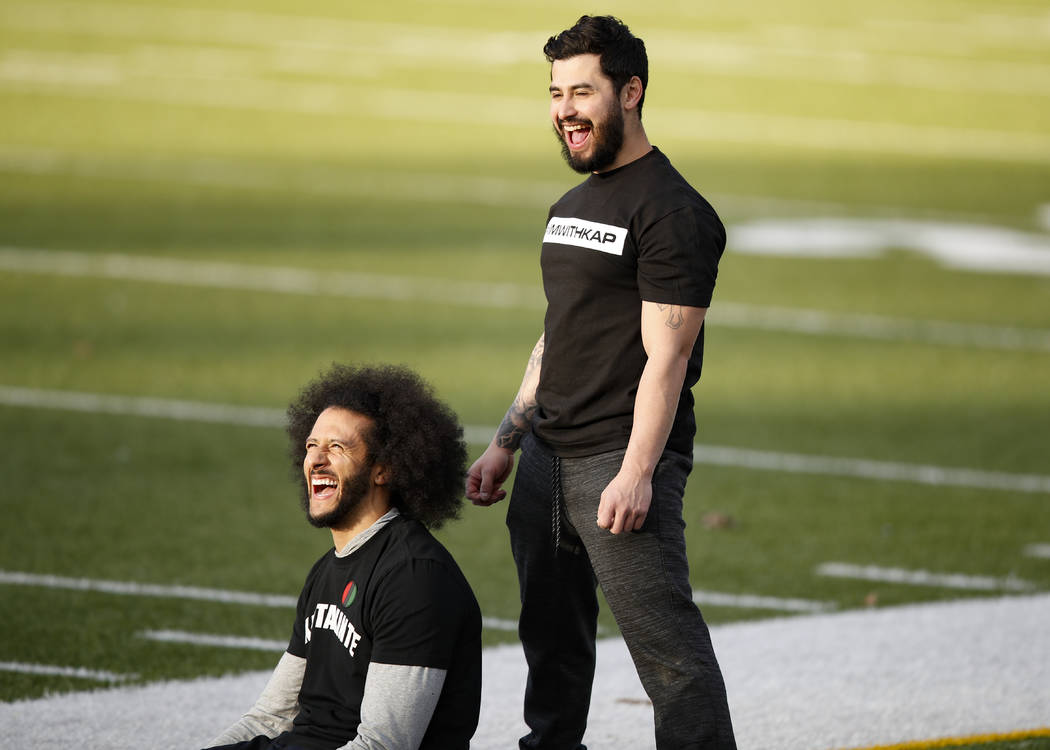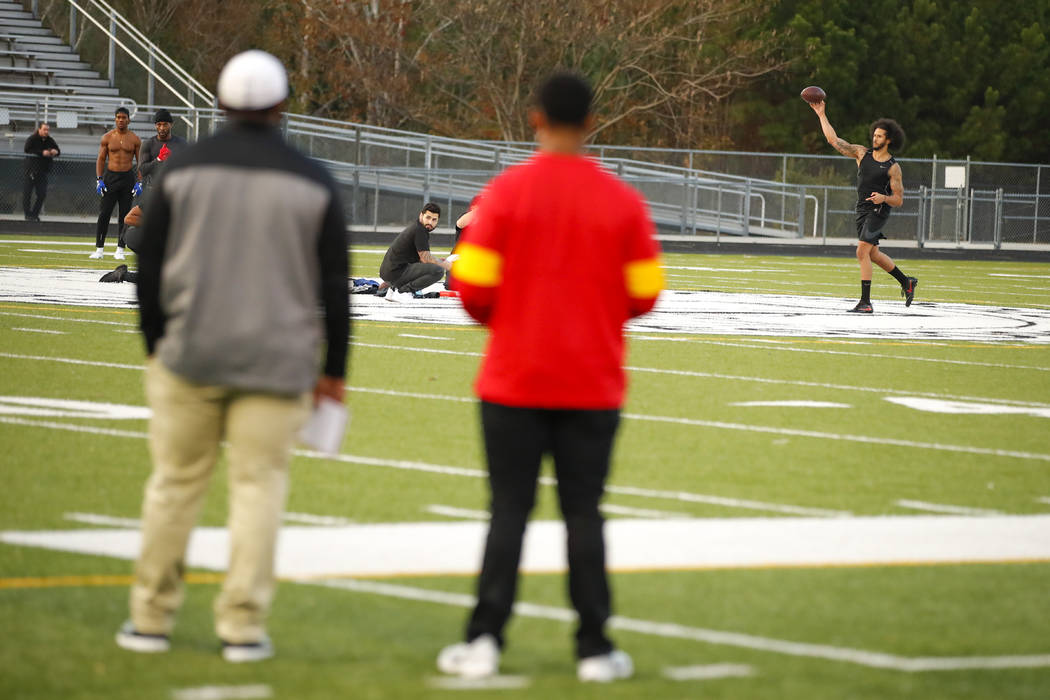Kaepernick, NFL trade blame game over botched workout
A week after Colin Kaepernick’s NFL workout fell apart, disagreements and distrust about it remain on issues such as its timing, who was invited and who could film the quarterback.
In conversations with The Associated Press, representatives from both sides blamed each other for what went wrong on Nov. 16. Kaepernick’s side said the NFL orchestrated a workout as a public relations stunt destined to fail, while the league said it gave him a real chance to show off his skills — and he didn’t show up.
A total of 25 teams were supposed to attend the league’s workout run by two former head coaches at the Atlanta Falcons’ practice facility. Instead, Kaepernick ditched that workout and ended up throwing passes in front of representatives from eight NFL teams at his own event at a site 60 miles away.
Kaepernick, who led the San Francisco 49ers to the Super Bowl seven years ago, hasn’t played since 2016 when he sparked a wave of protests and divisive debate by kneeling during the national anthem to protest police brutality and racial injustice. The league in February settled a collusion grievance filed by Kaepernick and Eric Reid.
The AP reviewed both waivers from the event and talked to a person who was involved in the negotiations from Kaepernick’s side and two NFL officials with knowledge of the process, all speaking on condition of anonymity because the discussions between the two sides were private.
A look at the issues raised by both sides regarding the botched workout:
Deadline to accept
Kaepernick’s camp said the NFL gave him only two hours to accept an invitation four days ahead of the workout. His side questioned the timing, purpose and motivation behind a take-it-or-leave-it offer presented in Week 11. They believe the NFL cared more about creating the impression it wanted to give Kaepernick a chance for a new job than actually giving him a legitimate opportunity.
The NFL said it was Commissioner Roger Goodell’s idea to give Kaepernick a platform for an unprecedented workout. The league, which hasn’t arranged tryouts for other free agents, said Goodell felt it was right to give the exiled QB the chance to showcase his skills. Teams were expressing interest in knowing whether Kaepernick was serious about playing. Kaepernick posted on social media that he was working out five days a week and ready to play again. Goodell spoke to other league officials and people outside the organization and decided an open tryout would give teams an opportunity to see for themselves. Jay-Z, who is in a partnership with the NFL, was involved in the conversations. Goodell also spoke to Dr. Harry Edwards, a civil rights activist.
Saturday instead of Tuesday
Kaepernick’s side requested to move the workout to a Tuesday when most teams bring free agents in for tryouts. It was concerned that team “decision-makers” wouldn’t be present on a weekend.
The NFL said coaches wouldn’t travel on a Tuesday or any other day during game week to see a free agent. It also said general managers rely on their scouts to evaluate free agents. The league says it didn’t want to push the date back because it “did not want a circus.” The league pointed out that free agents are usually given a call one day before a workout, “don’t bring in their own receivers, dictate the order of the workout, bring in their own media crew or have media onsite.”
Closed to media
Kaepernick’s side wanted to open the workout to the media to ensure transparency.
The NFL said it made clear from the start the workout would be closed to media. The league wasn’t comfortable opening Atlanta’s practice facility to media and says it wanted to give Kaepernick “the best platform from which to perform,” and having camera crews present wouldn’t help him concentrate on the workout. It said the issue of media presence didn’t come up until the day of the scheduled workout.
Attendees
Kaepernick’s camp said the NFL agreed to provide a list of team representatives who committed to coming. The league later shifted and did not share that list.
The league said it never made that promise because it didn’t want individual team personnel to face media questions leading up to the workout.
Uncertain details
Kaepernick’s team said he didn’t know which receivers he’d be throwing to and what routes they would run, so he brought in his own guys. He also wasn’t immediately informed that former Browns coach Hue Jackson would run the workout along with former Dolphins coach Joe Philbin.
The NFL said it understood those concerns and addressed them to Kaepernick’s satisfaction. It said it even complied with Kaepernick’s request on the morning of the workout to change the order of events and begin with a throwing session instead of Jackson’s original plan to start with the interview portion.
Nike’s role
The NFL said it agreed to Nike’s request to shoot an ad featuring Kaepernick and mentioning all the teams present at the workout. The league said the ad was supposed to be a social post featuring handwritten notes by a young Kaepernick that said he wanted to be a football player when he grew up.
A spokesman for Nike said the company did not have a film crew at the workout and declined further comment.
The film crew
Kaepernick’s side wanted to bring their own film crew because they didn’t trust that the NFL would provide accurate video and were concerned the league would edit it to make him look bad.
The NFL said it invited Kaepernick’s representatives to sit in with the Falcons’ video director at the facility to ensure the crew was capturing all the footage. The league said it planned to send the raw video to all 32 teams.
The waivers
Kaepernick’s representatives said the NFL “demanded” as a precondition for the workout that he sign an “unusual liability waiver” that addressed employment-related issues. They countered with a waiver from physical injury that the league rejected.
The NFL said it sent Kaepernick a standard liability waiver based on the one used by National Invitational Camp at all NFL Combines and by teams when trying out free agents. Kaepernick signed a waiver with similar language before attending the combine in 2011.
The NFL said it became concerned when Kaepernick’s side wanted to know who would own commercial rights to the video, adding that such an issue is not part of a typical workout.
Kaepernick’s side says it was concerned that not only did the NFL document seek to waive employment rights, but it contained a clause that would give the NFL and its teams commercials rights to the workout footage that could be used for what it called “phony” public service announcements and other “NFL marketing gimmicks.” The waiver provided by Kaepernick’s camp did not grant the commercial rights to anyone.
The NFL disputes the interpretation of the clause, saying it was intended to enable the video to be sent to the clubs for evaluation with no marketing or commercial use. The league says it provided the waiver on Wednesday, didn’t hear back on it until Friday night, and didn’t receive a revised waiver until 12:03 p.m. on the day of the workout.
Final words
Kaepernick’s side believes the NFL was using the workout as a PR stunt and wanted to avoid the NFL using the footage “for its marketing and propaganda since the NFL waiver included a clause granting it these rights.”
The NFL said it accommodated all of Kaepernick’s football requests, but nonfootball issues derailed it. The league said it would have invited the NFL Network to broadcast the workout if it wanted publicity.





















